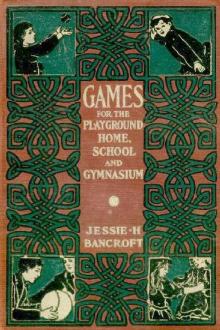Games for the Playground, Home, School and Gymnasium by Jessie Hubbell Bancroft (top novels of all time .txt) 📕

- Author: Jessie Hubbell Bancroft
- Performer: -
Book online «Games for the Playground, Home, School and Gymnasium by Jessie Hubbell Bancroft (top novels of all time .txt) 📕». Author Jessie Hubbell Bancroft
10 to 100 players.
Playground or gymnasium.
Any ball; indian club; bean bag.
The players are divided into two or more groups which compete against each other, each having a ball. Each group stands in single file in leapfrog position, feet wide apart to form a tunnel through which the ball is passed. The first players (captains) of each file toe a line drawn across the ground, and at a signal put the ball in play by passing it backward between the feet. When players become expert, one long shot will send the ball to the end of the line. The other players may strike it to help it along as it passes them if it goes slowly. Should the ball stop, or go out of bounds at any place, the player before whom this occurs must put it in play again, starting it between his feet. When the ball reaches the rear of the file, the last player runs with it to the front, the line moving backward quickly one place to make room for him, and immediately rolls the ball back again between the feet. This is repeated until the "captain" is the last player. He runs forward with the ball, places it on a marked spot twenty feet in front of his line, and returns to his place at the head of the file. The file wins whose captain is first to return to his original position.
Should there not be space for a point at which to leave the ball, the game may be finished by the last player holding up the ball when it reaches the end of the line, or by his running forward with it to the head of the line.
An Indian club instead of a ball makes a much more skillful game, the club being shoved over the ground, neck first. It is much more difficult to guide than a ball, requires greater deliberation for a long shot, and more easily stops or goes out of bounds. A basket ball or smaller ball may be used.
This is one of the best games for training self-control under excitement, as the precision needed for a long shot, especially with the Indian club, is very difficult under the circumstances.
TEN TRIPS6 to 21 players.
Playground.
Baseball; tennis ball.
This game is a competition between two or more teams, and consists in rapid pitching and catching of a base or tennis ball by each team.
A team consists of three players, two of whom stand a long throwing distance apart (thirty yards or more), with the third player (Number One) halfway between and on a line with them. Number One (the pitcher) starts the game on a signal by throwing the ball to one of the end players (Number Two); he throws it over the head of the pitcher to the opposite end player (Number Three), who throws it back again to Number Two, and he makes the last throw, sending it to the center player, or pitcher, Number One, from whom it started. This is called one trip, and the pitcher, as he catches it, calls out "One!" or "One trip!" and immediately begins the next round. The players standing in the following order, 2, 1, 3, the order of the throwing is thus, 1, 2, 3, 2, 1. Ten trips complete a game.
The competing teams stand in line sideways with the first team, and the pitchers of all teams start at once on a signal. The team wins which first completes ten trips. Any number of teams may play at once.
This game is very popular at Williams College, where it probably originated.
TETHER BALL
By kind permission reprinted from Spalding's Athletic Library TETHER BALL
2 to 8 players.
Out of doors.
This is one of the most delightful and vigorous games, especially adapted to small playing space, a plot twenty feet square being enough for it. The paraphernalia for the game consists of a wooden pole placed upright, so that it shall stand ten feet above the ground. The pole must be embedded deeply enough to be perfectly firm during the strain of the play. It will probably need to be about three feet below the surface. A pole should measure seven and a half inches in circumference at the ground, and should taper toward its upper end. A black stripe should be painted around it six feet above the ground.
To the top of this pole a ball is attached by a stout linen cord or fishing line. The ball should be preferably a tennis ball, and should have a netted cover, by means of which it is attached to the cord. No metal should be used around it in any way. The cover may be knotted or crocheted of heavy linen cord or fish line. When hanging at rest, the ball should be seven and a half feet from the top of the pole, and two and a half feet from the ground. The ball is played upon by tennis rackets in the hands of two players.
A tether-ball outfit, consisting of pole, ball, cord, and marking ropes, with staples for the ground as hereinafter specified, may be had for from three to four dollars, the ball alone, with cover and cord, costing about seventy-five cents, and the pole from one dollar to a dollar and a half. It is particularly desirable to have the specially made ball and cord for this game, but any of the paraphernalia may be improvised, the pole being cut from a sapling, and even the bats whittled from strips of thin board about the size of a shingle.
On the ground around the pole a circle should be drawn three feet in radius; that is, six feet in diameter. A straight line twenty feet in length should bisect the circle to separate the territory for the players. In addition to the circle and line, two spots should be marked on the ground, from which the ball is served. These should be at the ends of an imaginary line crossing the first line at right angles, and should be six feet from the pole, one on each side of the ground.
Where there are more than two players, they are divided into two opposing groups, each member of a team or group stepping forward, in turn, to play with the member of the opposite team. Only these two play upon the ball during one game.
The game consists, on the part of one player, in trying to wind the cord with the ball attached around the pole above the line by batting it with his tennis racket. The opponent tries (1) to interfere and reverse the action of the ball by batting it in the opposite direction, and (2) for his part to wind the ball around the pole in his direction.
The players toss rackets or resort to some other method of choosing sides of the ground. The game starts with each player on his service point; the player who lost in the toss for choice of ground has the first service. The player who has the choice of ground has also the choice of direction in which to wind the ball.
The ball is then put in play by the server, who may hit the ball but once. Should he fail to send it across the line with his first serve, he loses his serve and the opposite player has the ball. The players have each one strike at the ball in turn. It is sometimes possible to send the ball so high and with so much force that it will wind around the pole in one stroke, before the opponent can hit it with his racket. Of course such strokes should be the endeavor of both sides.
Should a player fail to hit the ball, the opponent has the next turn, either on service or after the ball is once in play.
Each player must keep entirely on his own side of the dividing line, both with his feet, his arms, and his racket. Neither player may step on or over the circle about the pole. If the string winds around the handle of a racket of one of the players, it is a foul. It is also a foul for the string to wind about the pole below the black mark, and counts against the player in whose direction it is wound; that is, if it winds in the direction in which he is trying to send the ball. Penalty for transgression of any of the above rules (fouls) is allowing the opponent a free hit from his service mark. When a ball is taken for service in this way, if it has to be either wound or unwound on the pole a half turn, so as to reach the other side, it shall be unwound.
The game is won when the string has been entirely wound around the pole above the limit line. When there are but two players, the one wins who has the majority out of eleven games. Where there are more than two players, the team wins which has the greatest number of games to its credit at the end of from two to five rounds, as may be decided at the opening of the series.
THREE HOLES2 to 10 or more players.
Out of doors; seashore.
Small ball.
This game is played by rolling a ball about the size of a golf ball into holes made in the ground. Three holes are made by spinning on the heel. They should be in a straight line, at a distance of from six to fifteen feet apart. At the same distance from them and at right angles to them, a line is drawn from which the players roll their balls. The first player stands with his heel on the bowling line and rolls his ball into hole number one. If successful, he takes his ball out of the hole, places his heel in the hole, and rolls the ball to hole two. If successful, he repeats this play for hole three, and then turns around and rolls the ball back again into hole two and then into hole one. Having done this, he starts again at the line and rolls the ball successively into each of the three holes until he reaches number three a second time. When this is accomplished, he has won the game.
The probabilities, however, are that the player will not succeed in making the holes so quickly as here described. Whenever a player's ball fails to get into a hole, he leaves it where it lies and gives place to the next player. The next player has the choice of aiming for the hole or for his antagonist's ball, the latter being a desirable play if it lies in a position that makes a shorter roll than to his own. Having hit this ball, he then rolls from that position to the hole. Should he fail to make either his opponent's ball or the hole, his ball must lie where it stopped, and the next player takes a turn. A skillful player will be able to play on his antagonists' balls so as to serve his own in making short rolls between holes. Whether the play be interrupted by failures of different players or not, the player wins who first rolls his ball up the line,





Comments (0)